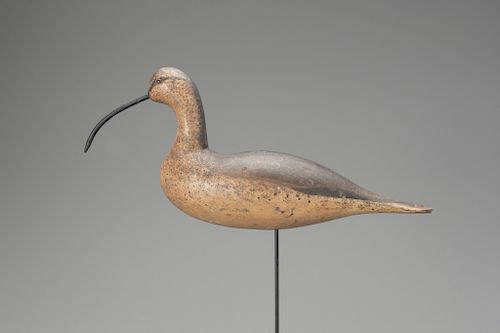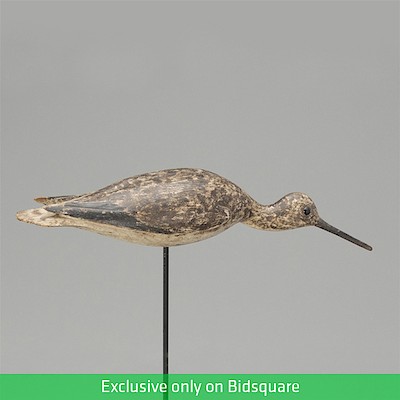The Peabody Essex Long-Billed Curlew, Mason Decoy Factory (1896-1924)
Lot 237
About Seller
Copley Fine Art Auctions
20 Winter Street
Pembroke, MA 02359
United States
Founded in 2005, Copley Fine Art Auctions is a boutique auction house specializing in antique decoys and American, sporting, and wildlife paintings. Over the course of the last two decades, the firm has set auction records for not only individual decoy makers, but also entire carving regions. Copley...Read more
Estimate:
$30,000 - $40,000
Absentee vs Live bid
Two ways to bid:
- Leave a max absentee bid and the platform will bid on your behalf up to your maximum bid during the live auction.
- Bid live during the auction and your bids will be submitted real-time to the auctioneer.
Bid Increments
| Price | Bid Increment |
|---|---|
| $0 | $50 |
| $1,000 | $100 |
| $2,500 | $250 |
| $5,000 | $500 |
| $10,000 | $1,000 |
| $25,000 | $2,500 |
| $50,000 | $5,000 |
About Auction
By Copley Fine Art Auctions
Jul 20, 2018
Set Reminder
2018-07-20 10:00:00
2018-07-20 10:00:00
America/New_York
Bidsquare
Bidsquare : The Sporting Sale 2018, Day 2
https://www.bidsquare.com/auctions/copley/the-sporting-sale-2018-day-2-3302
On July 19, Copley Fine Art Auctions will lead off their annual Sporting Sale with 140 lots from the Donal C. O’Brien, Jr. Collection of Important American Sporting Art and Decoys. On July 20 Copley will present an additional 425 lots of decoys, fish carvings, and sporting art. Copley Fine Art Auctions cinnie@copleyart.com
On July 19, Copley Fine Art Auctions will lead off their annual Sporting Sale with 140 lots from the Donal C. O’Brien, Jr. Collection of Important American Sporting Art and Decoys. On July 20 Copley will present an additional 425 lots of decoys, fish carvings, and sporting art. Copley Fine Art Auctions cinnie@copleyart.com
- Lot Description
The Peabody Essex Long-Billed Curlew
Mason Decoy Factory (1896-1924)
Detroit, MI, c. 1900
18 in. long
The provenance of this decoy was not listed when it last sold in April of 2000. Writing for "Decoy Magazine" after the auction in 2000, Jackson Parker discusses this exact bird, stating, "I thought it was equal or better than the McCleery curlew which was loaded with provenance." Collectable Old Decoys owner Dick McIntyre, who procured the decoy for the consignor concurred, writing at the time, "the best one I've ever seen!"
Parker in hispost auction article goes on to reveal The Peabody Essex Museum as the consignor. Evidently, the museum had acquired this curlew in 1945 and it had remained in their collection for fifty-five years. Parker also states the museum's reason for deaccessioning the curlew: "...to provide funds for the acquisition of Massachusetts classics." The museum’s “SB 16” code is painted under the tail.
In their 1993 publication on Mason decoys, Goldberger and Haid discuss curlew by Mason as being “huge; the bodies alone are 12-inches long.” This larger example measures thirteen and one-quarter inches from the tip of the tail to the front of the breast.
William J. Mackey, Jr. writes in Classic Shorebird Decoys: A Portfolio of Paintings, "Mason's skilled company of woodworkers and artists turned out numerous fine decoys...The Mason curlew...in original paint...would be one of the finest of factory shorebirds. Mason's paint was of unusual high quality...it has mellowed with age, but still retains the original luxurious, gemlike coloring. The method of application was also peculiar to Mason decoys. The paint is applied in a swirling pattern that made it stand up well against the roughest treatment and the saltiest Atlantic tidewaters. The painting style of Mason's decoys is fixed in a traditional, rather rigid pattern, but there is never a feeling of monotony, but rather one of rich ornamentation."
This decoy exhibits the finest work of Mason's painters. Unrestored and in near mint condition, with excellent provenance, it ranks as one of the top Mason decoys known to exist.
Original paint with light gunning wear, and an age line on the underside.
Provenance: Mrs. Edward Eldredge Collection
Peabody Essex Museum Collection, gifted from the above, 1945
Mark Smith Collection, acquired 2000
Literature: Milton C. Weiler and William J. Mackey, Jr., "Classic Shorebird Decoys: A Portfolio of Paintings," New York, NY, 1971, pl. 12.
Russ J. Goldberger and Alan G. Haid, "Mason Decoys: A Complete Pictorial Guide," Burtonsville, MD, 1993, pp. 106, 107, 136, and back dust-jacket cover, similar decoys illustrated.
Alan G. Haid and Brandy S. Culp, "The Allure of the Decoy," Charleston, SC, 2013, p. 61, similar decoy illustrated.
Jackson Parker, "Auction News," Decoy Magazine, May/June 2000, pp. 40-42, p. 40, exact decoy illustrated.Condition report requests can be made via email or by telephone (info@copleyart.com or 617.536.0030). Any condition statement given is a courtesy to customers, Copley will not be held responsible for any errors or omissions. The absence of a condition statement does not imply that the lot is in perfect condition.Condition
- Shipping Info
-
Shipping info
Copley Fine Art Auctions does not handle the shipping of any items. Shipping is the sole responsibility of the buyer. Once your payment has cleared, and we have received your authorized shipping release form items may be released for shipment. Copley Fine Art Auctions, LLC shall have no liability for any loss or damage to such items. Buyers should allow up to four weeks for shipment.PLEASE BE AWARE THAT INTERNET BIDDERS MAY NOT PICK UP THEIR ITEMS AT THE SALE SITE. ITEMS CAN BE PICKED UP BY APPOINTMENT OR SHIPPED STARTING FIVE DAYS AFTER THE CONCLUSION OF THE SALE
-
- Buyer's Premium



 EUR
EUR CAD
CAD AUD
AUD GBP
GBP MXN
MXN HKD
HKD CNY
CNY MYR
MYR SEK
SEK SGD
SGD CHF
CHF THB
THB














